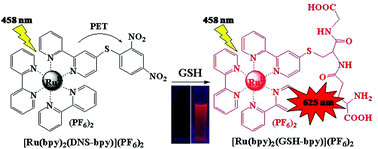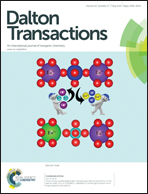A functional ruthenium(ii) complex for imaging biothiols in living bodies†
Abstract
A unique ruthenium(II) complex, [Ru(bpy)2(DNS-bpy)](PF6)2 [bpy: 2,2′-bipyridine, DNS-bpy: 4-(2,4-dinitrophenylthio)-2,2′-bipyridine], that can act as a probe for the recognition and luminescence sensing of biothiols has been designed and synthesized. Due to the presence of effective photo-induced electron transfer (PET) from the potent electron donor (Ru-bpy centre) to the strong electron acceptor (2,4-dinitrophenyl moiety), the Ru(II) complex itself is weakly luminescent. Reaction of [Ru(bpy)2(DNS-bpy)](PF6)2 with biothiols leads to the replacement of the 2,4-dinitrophenyl moiety by biothiols, which results in the loss of PET within the complex, to allow recovery of the MLCT-based emission of the Ru(II) complex with an 80-fold increase in luminescence intensity. Taking advantage of the high specificity and sensitivity, and the excellent photophysical properties of Ru(II) complexes, [Ru(bpy)2(DNS-bpy)](PF6)2 was successfully applied to the luminescence imaging of biothiols in living Daphnia magna. The results demonstrated the practical applicability of [Ru(bpy)2(DNS-bpy)](PF6)2 as a luminescent probe for the monitoring of biothiols in living bodies.


 Please wait while we load your content...
Please wait while we load your content...